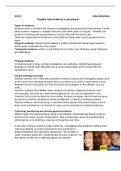Unit 3 miss johannes
Explain how evidence is processed
Types of evidence
Evidence which is central to the process of investigating and prosecuting crime because it is the
basis of which a suspect is charged, tried and found either guilty or not guilty. Therefore, the
process of collecting and storing evidence must be done with the utmost care.
There are several types of evidence e.g cctv, DNA and these types can be grouped into two
types:
Physical evidence- actual physical material e.g DNA extracted from blood stains,weapons,
stolen goods confiscated from the suspect.
Testimonial evidence- written or oral statements by victims, eye witnesses, expert witnesses
and defendants.
Physical evidence
An important part of many criminal investigations and collecting, transferring,storing and
analysing it must be done with great care to avoid contamination and to ensure that it is
admissible in court.
Locard exchange principle
Edmund Lochard (1877-1996) was a pioneer for forensic science and investigators always work
on the basis of the exchange principle, which is summed up as ‘every contact leaves a trace’.
Material from the crime scene (inc from the victim) will be present on the offender- and vice
versa.
Paul kirk- ‘wherever the offender steps, whatever he touches, whatever he leaves, even
unconsciously, will serve as a silent witness against him. Not only his fingerprints or his
footprints, but his hair, the fibres from his clothes, the glass he breaks, the tool mark he leaves,
the paint he scratches, the blood or semen he deposits or collects. It is factual evidence.
Physical evidence cannot be wrong, it cannot be wholly absent. Only human failure to find it,
study it and understand it can diminish its value.’ (on the importance of physical evidence)
Collecting, transferring and storing physical evidence
Different types of physical evidence needs to be collected, transferred and stored in order to
preserve them and to prevent contamination. Most contamination occurs by handling items
without gloves or by breathing, sneezing and coughing over them.
In the case of serious crimes e.g rape,murder etc. investigators wear protective clothing when
collecting materials, to avoid contamination and sometimes to
protect themselves from hazardous substances. This includes a
mask, a hooded ‘scene suit’, overshoes and two pairs of gloves. For
less serious crimes only a mask and gloves are required.
, Contamination was a serious issue in the murder of meredith kercher, where amanda knox was
accused, the labatory used a miniscule sample of DNA and tested it against 1000’s of other
DNA samples of meredith. As well as this protective clothing was rarely changed when forensics
were collecting evidence and gloves and correct shoes were sometimes not worn.
Bodily fluids and tissues
bodily fluids e.g semen, saliva, blood and tissue such as skin flakes and hairs can provide
important identification evidence, because DNA can be extracted from them and compared with
control samples from suspects to see if there is a match which would put the suspect at the
crime scene.
Blood- should be allowed to air dry. Fabric bearing wet blood should not be folded, as this will
cause the blood to transfer to other parts of the item. Items with dry blood on them should be
carefully packaged and sent as soon as possible and in any event within 24 hours to the
forensics laboratory for analysis.
Semen- may be found on clothing and bedding. If wet, should be allowed to air dry on the item.
Once dry, the item should be placed in a paper bag, which should then be sealed and placed
inside a polythene bag, again sealed and labelled. Each item should be packaged separately.
Where someone has been the victim of sexual assault, they should be examined as soon as
possible by a police surgeon or doctor and swabs taken.
Saliva- from bites inflicted on a victim can also be swabbed to provide a sample for DNA
analysis.
Skin flakes- we are constantly shedding small quantities of skin. These may be found at the
crime scene and can be analysed for DNA.
Hairs- may be found at the crime scene that can be matched with those of a suspect. In assault
cases, a victim's hair may be found on the suspect. If hairs are found on clothing, the item
should be wrapped in paper/ placed in a paper bag, sealed, labelled and then sent to the
forensics lab for analysis. Individual hairs found on furniture etc. should be wrapped or bagged
in the same way. DNA can be extracted from cells in the root to identify suspects or victims.
Finger prints
Fingerprints and palm,sole and toe prints are unique to each individual and so they are valuable
identification evidence. The prints are skin ridges on the fingers and they can leave impressions/
mars in or on surfaces. The marks can be from sweat or from contaminants in the skin,
fingerprints can be one of 3 kinds:
● Latent prints- invisible marks left on a surface that can be made visible by ‘dusting’ with
magnesium powder or shining an ultraviolet light on the surface. After photographing
them, prints may be listed using an adhesive strip and placed on an acetate sheet.
● patent(positive) prints- are visible to the naked eye. They may be left in substances
such as blood,ink,oil,powder or dust. They should be photographed for analysis and if
possible preserved for use in court.
● Plastic prints- three dimensional shapes made by pressing fingers into a soft material
e.g wet clay or the putty on a window frame. (plastic here, means easily shaped and
molded). They should be photographed and if possible mould made to capture a copy of
the impression.





